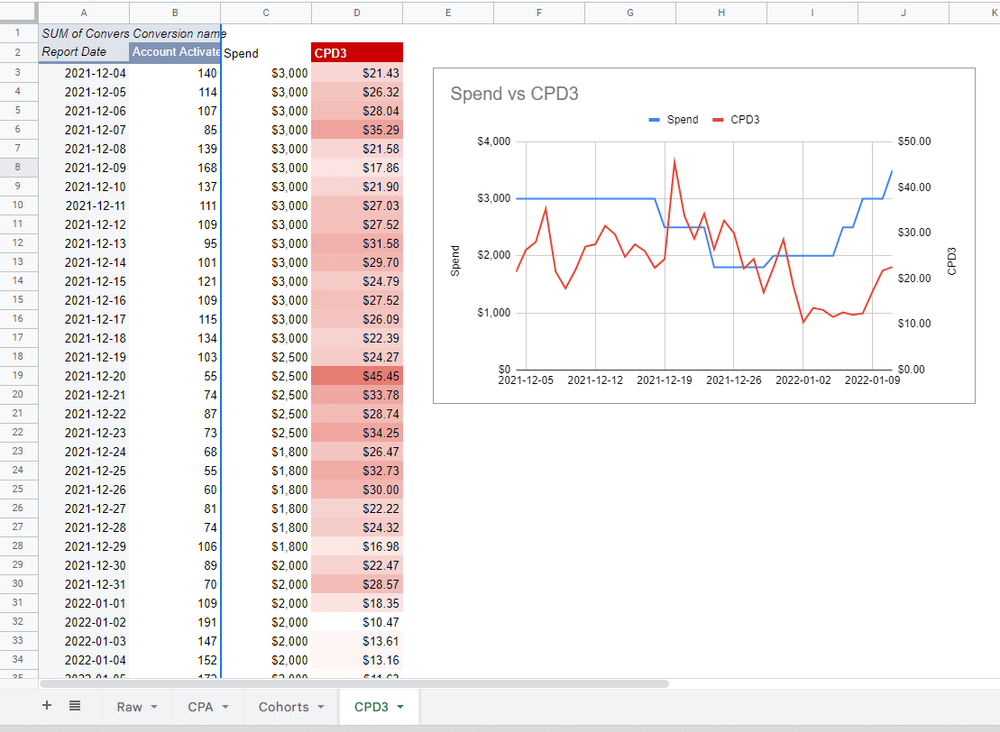It takes too long to optimize to that
How do you optimize your campaigns if conversions can take up to a couple of weeks to happen? If you compare this week to last week’s data, last week has had 7 more days to record conversions…
Cohorted Conversions
The key to optimizing for lagged conversions, is to cohort them so you’re comparing like-for-like...More
We really want to optimize to activations
But to do that we need to solve this lag issue
I’m wondering if we can just record what we would have seen on day 3
So for example instead of looking at data for last wednesday, which has had 7 days for people to activate cards, compared to this wednesday, which has had 1 day
Instead maybe we could cut the window to 3 days
So instead we’re looking at what wednesday’s performance would have been last saturday
Does that make sense?
Cohort the data, and filter for day 3 conversions
Take a look and see what’s possible
I’ll hook you up with a developer to record and pull the data
This course is a work of fiction. Unless otherwise indicated, all the names, characters, businesses, data, places, events and incidents in this course are either the product of the author's imagination or used in a fictitious manner. Any resemblance to actual persons, living or dead, or actual events is purely coincidental.
One thing that marketers consistently get wrong is not thinking in cohorts. When you spend money today on advertising, you aren’t guaranteed that the full benefit of that spend will occur the same day you spent the money. This is especially true for products where it takes some time for users to complete the conversion event. So for example if you had a banking app and some share of users take more than a week to convert, looking at performance week on week will be problematic as you’ll always be undercounting the current week. This might mean getting your spend allocation wrong by underspending, only to later see that the cost per acquisition (CPA) has come in better than expected later on as conversions ‘caught up’. This is an issue because it limits your volume when times are good, meaning you miss opportunities. It also can be a problem the other way, in that when times are bad and performance degrades, you don’t cut spend quick enough as you’re not sure where things will land after conversions come in. Waiting for a few weeks to make optimization decisions is too slow, and leaves serious money on the table.
The solution to this that I’ve found works is to think in terms of cohorted conversions. Rather than comparing last week to this week for example, compare day 3 conversions for both weeks. That way you’re comparing like for like – always a 3 day window – rather than giving last week an extra 7 days worth of conversions. To do this you need to record both the day that you’re reporting on, and the day in which you recorded the data, every day for the full conversion window (usually 28 days). Once you’ve done that you can artificially limit the window to 3 days, or whatever works best for your product, and compare apples to apples. What you’re in effect doing is looking back in time at what you would have seen if you looked at the report 3 days after that point in time, rather than what you see now. The hope being that if your Day 3 conversions are a consistent share of what your eventual Day 28 conversions will be, you can make optimization decisions in days instead of weeks, and be more confident of where you’ll end up when you look back on this time period next month. Working this way gives you a consistent and stable benchmark to compare against, and increases your flexibility in being able to respond quickly to opportunities or performance issues.
Complete all of the exercises first to receive your certificate!
Share This Course
